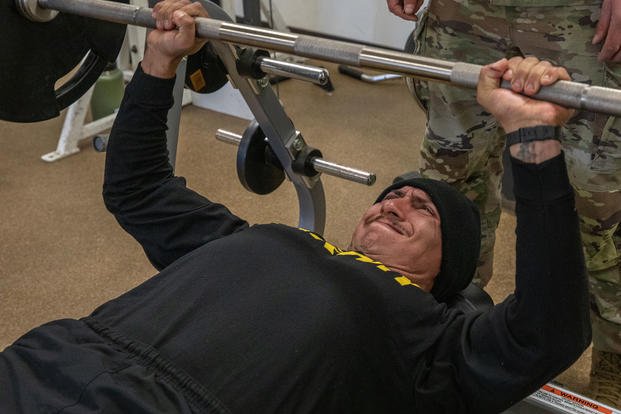Fitness
What Fitness Experts Want You to Know About Working Out While Sore

It finally happened. You went back to the gym after debating it for months, and your first workout felt good. The sweat and endorphins were flowing. But the following morning, you woke up aching in the areas you focused on. Now, the thought of lifting another weight or getting on a treadmill is painful. What’s the best path forward? Should you work out when sore; or take a few days off?
Meet the Experts: Carson Gantzer, M.S., C.S.C.S., performance physiologist with Human Powered Health, Alexander Rothstein, Ed.D., a NSCA-certified strength and conditioning specialist and instructor at the New York Institute of Technology’s Exercise Science program and Kristina Welsome P.T., D.P.T., O.C.S., C.F.M.T., M.T.C., assistant professor of clinical therapy at New York Medical College.
It can be easy to use soreness as an excuse to jumble up your gym routine. But the saying “no pain, no gain,” may have some truth to it. Below, fitness experts explain how to work (and rest!) through muscle soreness to reach your goals.
What is muscle soreness?
Muscle soreness is pain, discomfort, tenderness, and/or stiffness caused by micro-tears to muscle fibers, explains Carson Gantzer, M.S., C.S.C.S., performance physiologist with Human Powered Health. The tears are often a result of eccentric exercises that forcibly lengthen muscles, he adds. And although the term “micro-tears” sounds scary, the acute damage is actually believed necessary to help test and grow muscle over time.
Muscle soreness can be minimal and disappear within minutes or hours, or it can be longer-lasting, which is known as delayed onset muscle soreness or (DOMS), adds Alexander Rothstein, Ed.D., NSCA-certified strength and conditioning specialist and instructor at the New York Institute of Technology’s Exercise Science program.
DOMS can range from stiffness to severe, restrictive pain depending on the extent of the training, Rothstein explains. It’s not fully understood why such achiness kicks in after a particularly intense or new workout, “but it is believed to be from structural damage to muscle and cell membranes” caused by excessive tension on the muscles, he adds. That damage then creates an inflammatory response that activates pain receptors and swelling in the affected areas, which is why, after leg day, squatting to pick something up may be particularly grueling.
Thankfully, muscle soreness “is completely normal” to experience after working out, says Kristina Welsome P.T., D.P.T., O.C.S., C.F.M.T., M.T.C., assistant professor of clinical therapy at New York Medical College. “It happens to all of us at sometime, usually when we start exercising for the first time or after a period of non-exercise, when we add a new type of exercise, or when we push ourselves a little bit harder to get past a plateau,” she explains.
What does muscle soreness feel like?
“Muscle soreness is classified as a muscle strain and is perceived as stiffness, aching, or tenderness,” says Rothstein. Depending on the muscle groups you exercised most recently, you might find it difficult to do regular movements like lower yourself to a chair or raise your arm to open a cabinet.
Should I work out when sore?
DOMS is the body’s normal physiological response to the good stress (called eustress) of a hard workout, Welsome says. In other words, it’s not always a bad thing. It’s your body’s way of rising to the challenge and making physical change, so the best way to move on from it is actually to keep moving, she adds.
Eventually, each time you work out, you’ll progress to a place of being in no or little pain afterward, Welsome says. That’s the ultimate goal of exercise.“So, the best treatment for DOMS is actually the prevention of it by continuing to be a lifelong exerciser and not leading a sedentary lifestyle,” she concludes.
Of course, soreness and pain exist on a spectrum, and there is also time for rest and rehab before getting back to leg day. It’s all about balance. “Movement is good for repair and recovery, but it should be at a low enough intensity so that it does not cause additional damage,” Rothstein says. “Research has shown that movement can also help to lessen the sensation of pain, particularly the pain caused by stretching or activating the damaged tissue.”
How to work out when sore
“If you feel stiff or sore in the muscles you exercised, the best thing to do is be respectful and honor the feedback your body is giving you,” says Welsome. The worst things you could do, she adds, are either repeating the same intense exercise or doing nothing at all. So, she recommends alternating the types of workouts you do day to day to avoid both DOMS and becoming sedentary.
So, you might switch up weight training or high-intensity training with lighter, aerobic exercise like cycling or swimming, Welsome recommends. Stretching and mobility in the form of yoga or tai chi are also good options. “There is no one-size-fits-all all answer, but variety in terms of exercise type, intensity, and duration are good ways to meet your exercise goals without causing harm,” she says.
How to recover from muscle soreness
There are plenty of techniques that may help ease your body back into more intense movement after taking it a bit too far.
Never skip warming up
Before going hard again, try low-intensity, dynamic movements to warm up the muscles and increase circulation like walking, riding a bike, or gentle stretching, says Rothstein.
Stay fueled
“Make sure you hydrate and eat a nutritious meal to provide your body with the materials it needs to recover and repair,” Welsome says.
Massage or foam roll
Foam rolling or massage (maybe in the form of a massage gun) may help release tension, says Welsome.
Temperature therapy
“Many people swear by a hot shower or sauna, Epsom salt baths, or a cold plunge,” Welsome says. “There is ample anecdotal and research-based evidence to support the use of hot or cold as you prefer.”
Sleep
Quality sleep is crucial to give your body and muscles time to recover and repair, Welsome says.
Avoid pain-killers if you can
It’s reasonable to reach for the Advil bottle when you’re struggling to stand up straight after hitting the gym. However, Rothstein says that non-steroidal anti-inflammatory drugs (NSAIDS) like over-the-counter painkillers “may potentially blunt the repair process and can hide the sensation of pain.” That then creates opportunity for you to overtrain again and worsen your condition overall.
When to be concerned about muscle soreness
If regular post-workout muscle soreness or stiffness becomes severe pain that lingers beyond three or four days, or gets worse over that period of time, concern is warranted. It could indicate that you’ve injured yourself or aggravated an existing injury, Welsome says. If you know you have an injury and experience burning, shooting pain in that area, you should slow or stop your workouts and reach out to a medical professional.
You Might Also Like









